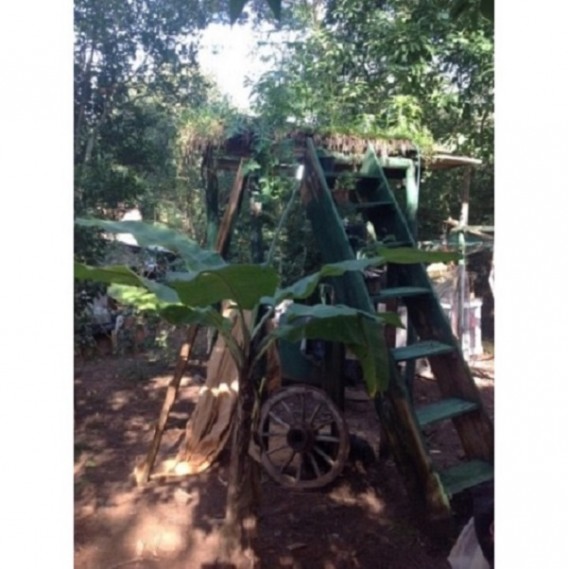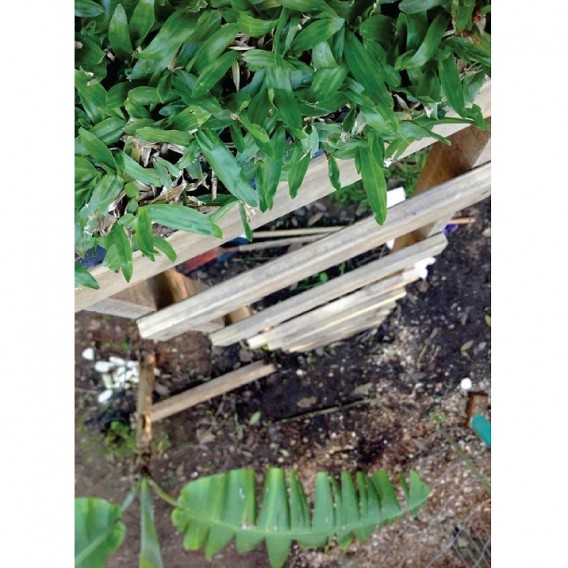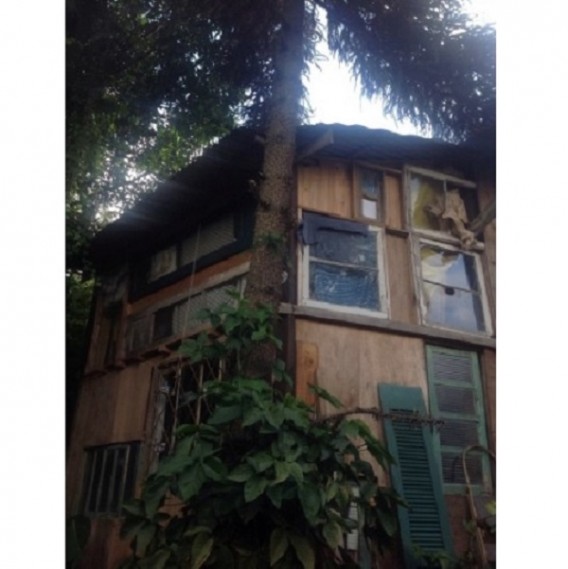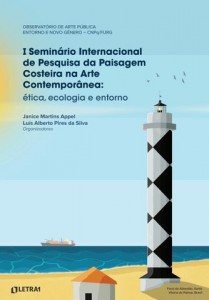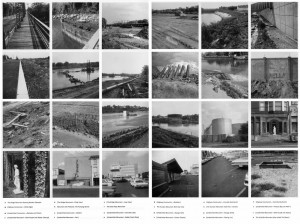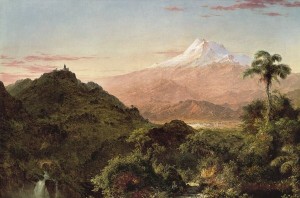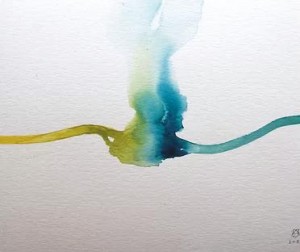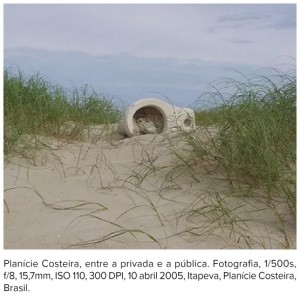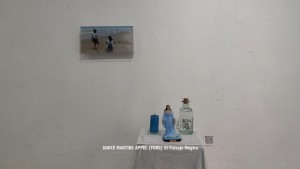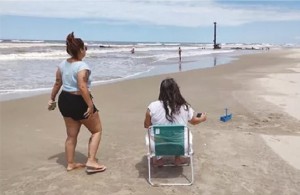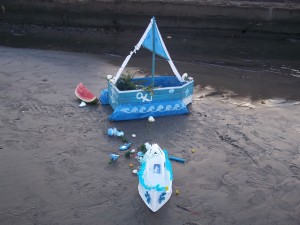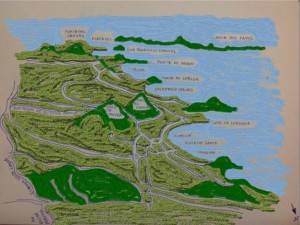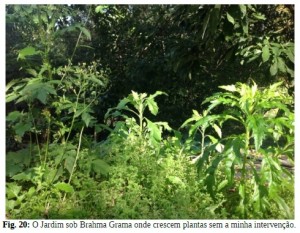“Entropy Garden under Brahma Grass”
The installation “Ecology: the necessary evil” specially designed and executed for the La Posta Foundation space by the artists Janice Martins Appel and Domingo Mestre (Serpiente de 2 Cabezas), with elements built specifically for the occasion and other natural ones as still lifes (in a multimedia context that includes various video projections, transparencies, etc.), it can be visited from May 12 to June 10, 2023 and will serve as the setting for a large program of activities. In addition to the performance by Janice and Domingo “Voices to the wind”, which will take place the same day as the opening (inspired by the book Ideas to Postpone the End of the World, by Ailton Krenak), this program of activities also includes the presentation on June 1 of the book I International Seminar on Coastal Landscape Research in Contemporary Art: ethics, ecology and environment, which took place from November 22 to 28, 2021 in Porto Alegre (Rio Grande do Sul, Brazil), organizedby Janice Martins Appel and Luis Alberto Pires da Silva, a presentation that will be given by José Albelda (participant in the Seminar and whose contribution has been included in the aforementioned publication, published in 2022), as well as a discussion on June 9with Elia Torrecilla and Cristina Ghetti, adjunct curators of the exhibition “Duas Beiras/Dues Ribes” (the curators were Domingo Mestre and Janice Martins Appel themselves), which took place in parallel to the aforementioned International Seminar, on the same dates, at Fantastik Lab (Valencia).As if all that were not enough, there will also be an intervention in the La Posta Showcase 24/7 by the artist Law Tissot, who also participated in “Duas Beiras/Dues Ribes”.An exhibition that could be seen later in Brazil, at the Instituto Cervantes in Porto Alegre, from May 12 to July 12, 2022.
Thus, the exhibition that we are now presenting at Fundación La Posta: “Ecology: Necessary Evil” is produced in the wake of this theoretical and practical project that combines an academic seminar and an exhibition of artistic works, all “between two shores”: between Rio Grande do Sul (Brazil) and Valencian Community (Spain).
Precisely because we are in the wake of these two events: the I Seminário Internacional de Pesquisa da Paisagem Costeira na Arte Contemporânea: ethics, ecology and environment, and the exhibition at Fantastik Lab “Duas Beiras/Dues Ribes”, is why it is worth notingin the content of those actions.
Janice Martins Appel and Domingo Mestre have been intensely involved in both. The latter refers in the book of the Seminar ―and, in the exhibition, he presented the work: “Autobiographical Landscape”― to that: “When, in January of last year [he refers to 2021], I was planning my last trip to Brazil,I was aware of the similarities of my living environment with that of Río Grande (RS), since I had already known the area for a long time.In both cases they are territories characterized by numerous fine sand beaches;As for the coastal lagoons, in the case of Valencia it would be worth talking about the Albufera lake;and large commercial ports with intense maritime traffic.In fact, if the Rio Grande Superport is considered the second most important in Brazil, the port of Valencia is the one with the highest commercial traffic in the entire Mediterranean.It would be easy to think that some photos taken in Valencia belong to Río Grande and vice versa”.And he showed two images at the conference, one made by himself: “Cassino Beach II” (in Río Grande), 2020, and another by Carles Solis, from the “Sub Urbe” series, Valencia, 2020.
Above, Cassino beach in Río Grande (photo Domingo Mestre) and below, Carles Solis, from the “Sub Urbe” series, Valencia.
Cassino beach, next to the city of Río Grande, is a space that bears similarities with the coastline of the Valencia metropolitan area, as Domingo Mestre points out, in addition to the most obvious, such as the large extension of the beaches, bothin length and width, which occurs both in one case and in the other, to which is added the proximity to a large port and a lake;In addition to all this, in both cases we find the typical elements of an entropic landscape, in which there coexists, without solution of continuity, vestiges of a nature that until recently had no contact with human activity, coexisting with industrial, portand other large infrastructures, which are leaving their chaotic mark on the territory.
A good example of what is being said, of contradictions and conflicts in these territories, is constituted, in the case of the coastal zone of the metropolitan area of Valencia, by the remains of abandoned industrial activities, such as the chimney that appears in the photograph that Domingo Mestre showed in his speech at the Symposium (by Carles Solis), probably the remains of a factory with an oven; or in the case of the Cassino beach, at a point close to the great mouth of the Lake of the Patos (which is at the same time the entrance to the port of Rio Grande), we find the presence of the wreckage of the ship Altair ―a shipwrecked ship among the many that navigate the area looking for mooring in the Port of Río Grande, one of the largest in Brazil―; both constitute entropic landscapes.
“Navio Altair”, Everton Cosme, watercolor on paper, 2019. It could be seen at the “Duas Beiras/Dos Orillas” exhibition that took place at Fantastik Lab in November 2021.
The painting tells of the shipwreck of the Altair ship on the beach of Cassino (to the south of Lake Los Patos, near the entrance to the port of Río Grande). As in the case of Caspar David Friedrich’s “Sea of Ice”, whose force changed language, giving a new meaning to the word failure, Everton Cosme’s work conveys melancholy for the ruins of the future, a typical postmodern phenomenon.
José Albelda, who also participated in the Seminar ―and in the exhibition “Duas Beiras/Dues Ribes”— referred to entropic landscapes.His intervention is included in the book that we are presenting now at Fundación La Posta, where he tells that entropic landscapes is a concept coined by Robert Smithson in his famous work “A tour of the monuments of Passaic, New Jersey” (originally published in ArtForum in 1967; its force does not stop expanding and the last edition has been produced in Gustavo Gili, in 2006, the architects’ publishing house). Maggie Gilchrist and James Lingwood commented on this work by Smithson in the text “The Entropologist”, included in the catalog of the exhibition “Robert Smithson. The Entropic Landscape. A Retrospective 1960-1973”, which took place at the IVAM in 1993:
- “Beginning in 1966, Smithson frequently wanders this landscape, seeking with his wife and collaborator Nancy Holt, and various artist friends, the post-industrial vedute of abandoned industrial or mining operations, the wounds and fragments produced by the capitalist system. In his essay “A Tour of the Monuments of Passaic,” published by Artforum in 1967 (which he would later describe as a kind of epilogue to William Carlos Williams’s epic), Smithson clearly avoided the sublime encounter of the Cascades and focused his Instamatic onthe ruined landscape of the riverbanks and the new road being built next to it.The 3 x 3-inch black-and-white snapshots form a kind of parody of the picturesque.In the anti-monuments of pumping rigs and old industrial pipelines, in the classically kitsch statue in front of a town house and parking lot littered with empty cars, in the empty sand pit and graffitied wall, Smithson rummages and examinesthe ruins of positivist culture.This was the spoil of progress, the entropic landscape that permeated Smithson’s work at every stage”.
Robert Smithson did in the sixties of the last century, what Alexander von Humboldt and Frederick Edwin Church had done a century before, acting in collaboration ―a scientist and an artist―, renewed the landscape genre. Alexander von Humboldt contributed the prevailing scientific vision in the 19th century ―with a notable tendency to identify and classify species, both plant and animal―, to which he would later give plastic form ―in the study, based on sketches taken from life― the painter Frederick Edwin Church.
Frederic Edwin Church: “South American Landscape”, 1856, Col. Carmen Thyssen, in which you can see the Chimborazo volcano, in Ecuador. A work carried out following ─literally─ in the footsteps of Alexander von Humboldt. In this sense, it should be noted that the image offered by the painting does not exist in reality. The distribution of the different elements that make up the painting has been carried out seeking to compose what we know today as ecosystems, according to Humboldt’s scientific way of proceeding.
But Smithson does it all himself, both the scientific and the artistic part (certainly in a propitious cultural context): he studies geology, crystallography and paleontology and worked in a firm of architects and engineers, probably participating in the realization of what is known todaysuch as the Environmental Impact Study for large infrastructure works, while learning to make photography and films (“Hotel Palenque”, 1969, and “Spiral Jetty”, 1970).With that background, and in a short period of time (because he died at 35), he carried out a renewal of the landscape genre the like of which had not been known for a century before.
Returning to José Albelda, he presented in the exhibition “Duas Beiras/Two shores”, a work, “Germinaciones del agua”, 2021, which is dependent on interdisciplinary approaches and the consideration of scientific knowledge in artistic work,of what Robert Smithson displayed in his short but intense life.
José Albelda, “Water sprouts”, 2021. It could also be seen at the “Duas Beiras/Two shores” exhibition that took place at Fantastik Lab in November 2021.
In the “Duas Beiras/Two shores” exhibition that took place at Fantastik Lab in November 2021, the following participated: Ana Navarrete, Almudena Soullard and Yael Vidal, Bia Santos and Emilio Martínez, Bruno Castoldi, Carlos Llavata, Claudia Washington, Cláudio Tarouko de Azevedo , Cristina Ghetti and Elia Torrecilla, Domingo Mestre, Estêvão da Fontoura, Everton Cosme, Fernando Rocha and Leandro Teixeira Castro, Janice Martíns Appel, José Albelda, José Saborit, Juliana Crispe, Law Tissot, Mariela Yabo, Massimo Mazzone, Olivia Godoy Collares, Oscar Mora, Pablo Paniagua, Roberto Verdum and Teresa Lenzi.
Roberto Verdum, Planície Costeira, entre a privada e a pública, 2005.
To speak of entropic or dialectical landscapes (which Robert Smithson called them both ways; he called them dialectical, for example, in the work “Frederick Law Olmsted and the dialectical landscape”, 1973), is to speak of contradictory, opposite, conflicting landscapes,in themselves and in relation to the landscapes that were described in the past.Because it must be taken into account that Smithson not only shows contemporary entropy, but also confronts the denialism of the past.He does so by setting himself up against William Carlos Williams and his long poem “Paterson” (1946), which tells of the town just off the Passaic where Smithson was born and grew up.He faces the epic tone of William Carlos Williams and the picturesque of the Paterson waterfalls, to show us the other side of reality, the one that corresponds to our times: industrial landscapes, huge parking lots (adjacent to shopping centers ormassive entertainment areas), iron and wooden bridges, public works under construction: “On the banks of the Passaic River there were many minor monuments such as, for example, concrete abutments that supported the sides of a new highway in full construction. River Drive was partly razed and partly intact; it was not easy to tell the new road from the old road; both were confused in the same chaos. As is well known, many machines were turned off, so they looked like prehistoric creatures trapped in the mud or, better, extinct machines: mechanical dinosaurs with their skin torn off” [from the edition of Alias of Mexico publishing house: “Robert Smithson. Selection of writings”, on page 91]. And he continues further: “In comparison with the city of New York, which gives the impression of being solid and compact, Passaic seems full of «holes». And those holes are, in a way, the monumental voids that define, without trying, the memory-traces of an abandoned series of futures. Such futures are discovered in utopian B-movies and are later imitated by the “suburbanite”. The windows of the City Motors auto shop herald the existence of Utopia through the 1968 WIDE-WHEEL PONTIACS —Executive, Bonneville, Tempest, Grand Prix, Firebirds, GTO, Catalina and Le Mans— and that visual incantation marks theend of highway construction” [Ibidem, p.92].
The participation of Janice Martins Appel both in the Seminar at the Federal University of Rio Grande (FURG) and in the exhibition at Fantastik Lab in Valencia was intense:
“From here and there, the one who protects is Lemanjá. Photography, lemanjá, glass of water from the sea of Valencia and fire, Praia do Cassino, Brazil.
“Margin here and there, who protects is lemanjá. Photo taken at Praia do Cassino, looking towards infinity that leads to the African coast. On the horizon we see a shipwreck called the Altair. We also found a boat of offerings for lemanjá. We always try to cross to the other shore and are also crossed by it. Two borders that exert colonizing tension, the threat of shipwreck for those who try to cross the border. Lemanjá makes us cross and protects us with his beauty” [From Janice Martins Appel in the Seminar publication, at the bottom of the photo that appears incorporated into the installation above, p. 130].
This installation by Janice Martins Appel “The magical landscape” includes a photographic image obtained on Cassino beach that is interesting to pay attention to in a little detail, because it is full of traces and vestiges of entropy, sometimes of a spiritual or magical nature:
In the photograph above, which completes the installation by Janice Martíns Appel in the exhibition “Duas Beiras/Two shores”, one of the boats can be seen, in the context of the Lemanjá or Yemayá celebration, in front of the women, votives that are popularly used in said celebration. And in the background, the shipwrecked Altair.
Janice Martins Appel has reformulated the concept of entropic landscape elaborated by Robert Smithson. In the conference she gave at the I International Seminar on Coastal Landscape Research in Contemporary Art: ethics, ecology and environment, a conference entitled: “The garden as a place of landscape in contemporary art” ―a conference based on his thesis “Garden: open-air experimentation laboratory”, Universidade Federal do Rio Grande (FURG), 2016―, where the idea of garden is addressed as a device, as a place of research and artistic production in contemporary art. And Janice wonders: “What does an artist and art researcher do in the Garden? This was the question I tried to answer when I found myself in a place as seemingly improbable in terms of the artistic field as being in a garden or parterre, manipulating plants and practicing cultivation.Note that here I am not referring to the historiography of art, where the garden is framed within a range of possibilities for drawing or for painting and sculpture.I am speaking here of an artist in the middle of the garden, manipulating plants and producing crops, where, therefore, the actions of an artist take place beyond a museum, gallery or formal cultural institution.This question that still haunts me today can be answered when we realize that art must slide between the different fields, spaces of knowledge, making possible the transversality with the different other fields and bringing to the forefront new ways of thinking to integrate art andlife.The constant processes of rupture in art ―between the 1960s and 1990s― eliminated the need for a traditional support in art, opening space for a dematerialized artistic object, no longer centered on the concept of the work itself, nor onits formal spaces, but in its founding process, capable of producing differences, new questions, thoughts and actions, thus expanding the possibilities of this action in new directions” [from the book of the Seminar, p.86]. And in this context, Janice Martins Appel raises the idea of a new garden that has to be used for collaborative practices, even more so, in the direction of permaculture, and for observation and meditation. “Garden is, therefore, the environment that is presented as a conceptual and partial context prior to the functions that emerged in Brahma Grama [the Brahma grass], a sculpture suspended four meters from the ground and that basically has simultaneous concepts of presentation: sculpture, intervention or piece of garden. At four meters high, we are placing the Garden in suspension and in a specific context, since there is an enlarged view of the environment, in which Brahma Grama is inserted” [from the book of the Seminar p.90].
“Brahma Grass in the Garden”, Janice Matins Appel, 2014 [images included in the thesis: “Garden: open-air experimentation laboratory”, 2016, p.60 and 242]To realize the size of the construction (4 m high), a good reference is the wheel that is supported below.
“[The Garden] can also be thought of from a micropolitical perspective, as a place for the exercise of a committed art, or in other words, of the activist practice that defends the potential of an ecological ethic together with the development of a creative process. and artistic perception. “In this way, Brahma Grass is described as a form of intervention that coexists with the development of the Garden’s anthropoflora, associated within a process of creating new reflection images and a new landscape, which I call “Jardim de entropies sob Brahma Grama” [Garden of entropies under the Brahma grass]” [from the book of the Seminar p. 90-91]. The artist tells us that: “Brahma grama is a work of art made outdoors. It is an environmental sculpture where you can climb a ladder and thus reach 4 meters above sea level where there is another garden. Brahma is the spiritual and Grama is the grass. Like a spiritual land art, and it is located in her garden in Rio Grande do Sud (Brazil) [next to Morro da Tapera, to the north of Lago los Patos, according to the map made by Janice herself included below].
Map of the metropolitan area of Porto Alegre to the south of the city, mapped by Janice Martins Appel (included in her thesis: “Garden: open-air experimentation laboratory”, 2016).The first thing that catches your eye is that the south is up.So, above is the lake of the Patos.
In the center of the map, Rua Pedro de Oliveira França and Morro da Tapera, where the “Garden of entropies under the Brahma grass” is located.
The entropy of the garden is found under the Brahma grass because, one must take into account that “the view under the Brahma Grama creates the illusion of a grassy ground.But if we look closely, this is an impossible reality since the treetops are at the same height as the grass…” [from the Seminar book, p.70].
And what we find under the Brahma grass is the garden of entropies:
The Garden under Brahma grass where plants grow without my intervention” [Janice Martins Appel in her thesis, pg. 74]
The concept of entropy in a garden, by Janice Martins Appel, is strongly influenced by the thought of Gilles Clement. She refers to him in several moments of his thesis “Jardin: open-air experimentation laboratory”, especially in the subchapter “3.6 Brahma Grass: possible entropies”. Gilles Clement is a gardener, landscape architect, botanist, entomologist and French writer, author among other books of The garden in movement (1991) and Third landscape manifesto (2004). His thinking reminds us of Robert Smithson, around the concept of entropy, but inverted. If Smithson pays attention to the appearance in more or less natural surroundings of elements that denounce the contradictions of the civilization in which we are immersed, the chaos caused by the development of increasingly complex societies, on his part Gilles Clement puts the attention on them possibilities for the development of salvage plant life in the interstices of the over-urbanization characteristic of contemporary metropolises. This is the entropy that applauds Janice Martins Appel when she proclaims the “Jardim de entropies sob Brahma Grama” [Garden of entropies under Brahma grass].
At La Posta Foundation we will have the opportunity to enjoy a garden of entropies under an autumn soil.


